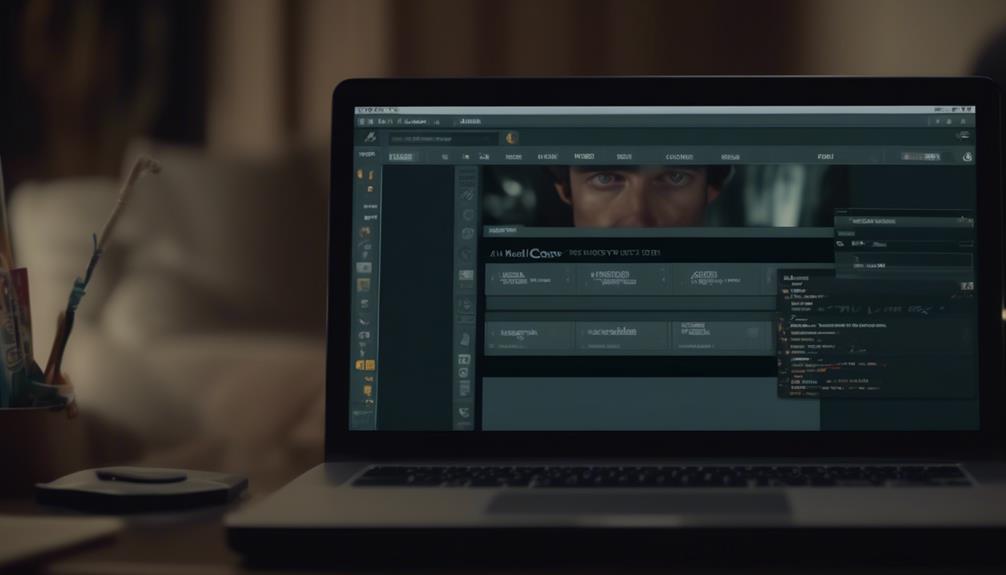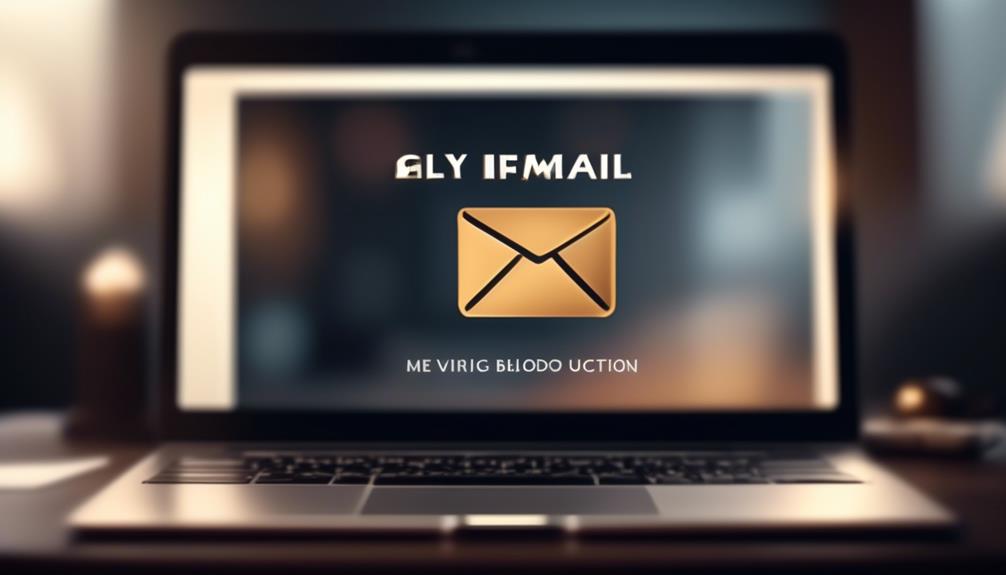Regarding modifying a Mailchimp template, there exist several essential steps of which numerous individuals might not be cognizant.
It's important to understand how to navigate the template editor and make changes to suit your needs.
Whether you're looking to customize the layout, adjust the colors and fonts, or simply add your own content, there are some effective techniques to master.
By learning the ins and outs of Mailchimp's template editing features, you can elevate your email marketing game and create visually engaging campaigns that resonate with your audience.
Key Takeaways
- Access and edit templates in Mailchimp by navigating to the 'Email templates' section in the 'Content' tab and clicking 'Edit'.
- Choose between using Mailchimp's visual designer tools or editing the template's HTML code directly.
- Save your changes by clicking 'Save' in the lower-left corner and 'Save and Exit' in the lower-right corner of the Template Builder screen.
- Seek assistance from Mailchimp's help articles or support options if needed.
Accessing Template HTML Code
To access the HTML code of a Mailchimp template for direct editing, we can follow these steps:
- Select the template and click 'Edit' within the 'Email templates' section after navigating to 'Content'.
- This will take us to the template editor, where we can delve into the intricacies of the template language and make precise adjustments to the code.
- In the template editor, we have the option to use Mailchimp's visual designer tools for quick modifications or click 'Edit Code' to directly manipulate the template's HTML.
- Once we are satisfied with the changes, we simply click 'Save' in the lower-left corner and then 'Save and Exit' in the lower-right corner of the Template Builder screen.
If we encounter any challenges during this process, we can find valuable assistance in Mailchimp's help articles. However, if our issue requires personalized support, we can access email and chat support as a paid user. This can be particularly beneficial for resolving more complex template code-related queries.
Customizing Section Design

Navigating to the 'Edit Design' option in the Content section of the campaign builder allows us to customize specific sections by adjusting preferences for background colors, font sizes, and link styling in the Style tab of the editor window. Here's how we can make the most of this feature:
- Access the 'Edit Design' option in the Content section of the campaign builder. This is where we can fine-tune the look and feel of our email campaigns to align with our brand and messaging.
- Navigate to the Style tab in the editor window during the design step. Here, we can access various customization options to modify the appearance of specific sections within our email template.
- Select the specific section you want to customize. By pinpointing the exact section we want to modify, we can ensure that our design changes are applied precisely where we need them.
Mastering the art of customizing section design can greatly enhance the visual appeal and effectiveness of our email campaigns. If questions arise, scanning a help article or reaching out to Support can help us find the information we need to resolve any issues.
Editing Links in Design View
When focusing on refining the design of our email campaigns, our attention naturally shifts to the process of editing links in the Design View. In Mailchimp's Design View, the process of editing links is straightforward.
Simply double-click on the link you want to edit, and the link properties window will appear, allowing us to make changes to the link text or URL. After making the necessary adjustments, clicking 'Save' will apply the changes to the link. For more advanced customization, the 'Edit Code' button enables us to directly modify the HTML of the link if needed.
After editing the links, it's essential to preview the template to ensure that the changes appear as intended. This step ensures that the links are displayed correctly and lead to the intended destinations.
Using Content Studio With Custom Template

How can we effectively utilize the Content Studio with a custom template to enhance our email campaign design and functionality?
When using a custom template in Mailchimp, integrating it with the Content Studio can significantly enhance the visual appeal and functionality of our email campaigns. Here's how we can make the most of this feature:
- Easily Linking Files: We can use the Content Studio to link files to our custom-coded template, making it seamless to incorporate images, videos, or other media into our email design.
- Finding Help Articles: Mailchimp provides helpful articles and videos that show how to use the Content Studio with custom templates. Utilizing these resources can resolve any issues we encounter and enhance our understanding.
- Troubleshooting Support: If we encounter any difficulties, it's easy to find help articles or a video that showed how to use the Content Studio with a custom template. Additionally, if Mailchimp doesn't work as expected, we can log in and seek technical support to resolve any issues promptly.
Creating Editable Content Areas
To create editable content areas in the Campaign Builder using Mailchimp's template language, learn the necessary techniques for modifying specific content sections with ease.
When editing a Mailchimp template, creating editable content areas is crucial for customizing your campaigns. However, help articles don't always make it easy to find the information you need. That's why it's important to understand how to create these editable spaces.
As users can log in and tell us about their experience, we can provide guidance on making these modifications.
In Mailchimp's Campaign Builder, you can create editable content areas by utilizing the template language. This allows you to define specific sections that can be easily customized without delving into complex code.
Frequently Asked Questions
How Do You Edit a Template in Mailchimp?
We edit a template in Mailchimp by following these steps:
- Log in to our account.
- Navigate to the 'Campaigns' section.
- Select 'Email Templates.'
- Choose the template we want to edit.
- Click 'Edit.'
- Customize the template by adding or removing content.
- Change colors and fonts.
- Adjust the layout.
- Save our changes.
- Use the updated template for our email campaigns.
How Do I Customize My Mailchimp Design?
Certainly!
Customizing your Mailchimp design involves leveraging the platform's Content Studio to tweak templates and utilize the template language for editable content areas and styles. This empowers easy modification and customization, enhancing the visual appeal of your emails.
How Do I Edit an Existing Campaign in Mailchimp?
To edit an existing campaign in Mailchimp, we first navigate to the 'Campaigns' section and select the campaign we want to modify.
Then, we click 'Edit' to access the campaign content.
From there, we can make adjustments to the text, images, and layout as needed.
After making the desired changes, we save the edits and proceed to send or schedule the updated campaign.
How Do I Edit an Existing Landing Page in Mailchimp?
When we edit an existing landing page in Mailchimp, we access the template by clicking on 'Content' and then 'Email templates' and select the template we want to edit.
After selecting the template, we click on 'Edit' to modify the template using Mailchimp's visual designer tools or by directly editing the HTML code.
We then save our changes by clicking 'Save' in the lower-left corner and then 'Save and Exit' in the lower-right corner of the Template Builder screen.
Can the skills for editing email templates in Quickbooks be applied to editing Mailchimp templates as well?
Yes, the skills for changing Quickbooks email templates can be applied to editing Mailchimp templates as well. Both platforms require similar knowledge of HTML and design principles, so the experience gained from one can easily translate to the other.
Conclusion
In conclusion, making adjustments to Mailchimp templates allows for personalized and tailored content to be delivered to your audience.
By utilizing the various editing tools and options available, you can create a visually appealing and effective email campaign.
It's important to take advantage of the flexibility and customization options provided to ensure your message is conveyed in the best possible way.









